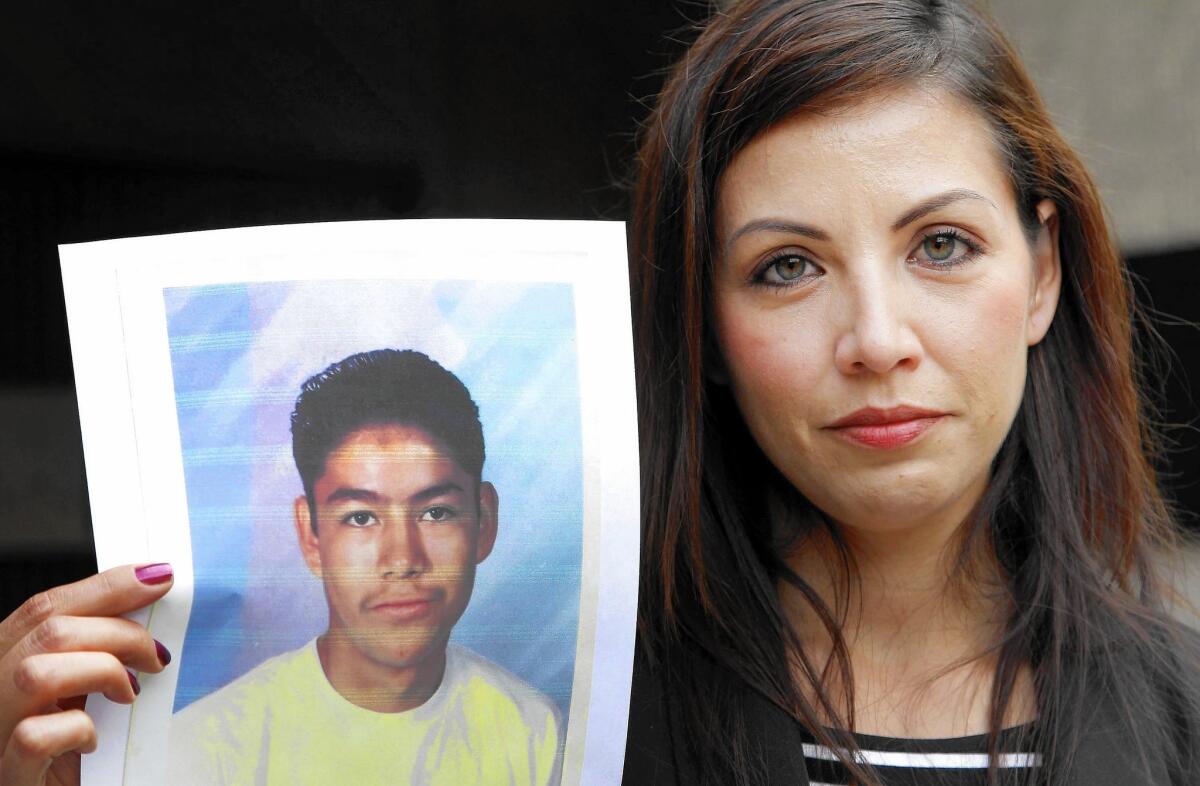California inmate’s parole reflects rethinking of life terms for youths

- Share via
Edel Gonzalez expected to die in prison for the crime he committed at 16.
For his role in the “savage, brutal and senseless” carjacking that ended in murder, an Orange County Superior Court judge in 1993 sentenced Gonzalez, who wasn’t the triggerman, to life in prison without the possibility of parole.
But on Tuesday, Gonzalez, now 39, was released from the custody of the state’s Department of Corrections and Rehabilitation — making him one of the first prisoners sentenced as a juvenile to be released since state lawmakers approved a landmark reform in 2012 that gave inmates like him the chance to earn parole.
In a statement released to his attorneys after he learned he’d be freed, Gonzalez said he wanted to encourage others who had received the same sentence.
“A light shines at the end,” he said. “Keep hope and faith.”
Gonzalez’s release is part of a national trend in rethinking life sentences for juvenile offenders. It is an acknowledgment that there is a developmental gap between juveniles and adults. In 2005, the U.S. Supreme Court abolished the death penalty for minors, and in 2012, the high court ruled that judges must consider a juvenile’s immaturity and capacity for change as factors in sentencing.
In California, about 310 prisoners are serving life prison sentences without the possibility of parole for crimes they committed before they turned 18, said Luis Patino, a spokesman for the corrections department. Nationwide, about 2,500 prisoners are serving life-without-parole sentences for crimes they committed as juveniles, said James D. Ross, spokesman for Campaign for the Fair Sentencing of Youth.
The California legislation, SB 9 — which comes into effect as Gov. Jerry Brown has been paroling more “lifers,” including adults convicted of murder — shows how the state has “evolved,” said Elizabeth Calvin, a children’s rights advocate at Human Rights Watch.
“It really shows that California is on the right track,” she said, “that it’s trying to shape its laws with what we know is true: That young people have a capacity to turn around their lives.”
But Jennifer Bishop-Jenkins, who helped found the National Organization of Victims of Juvenile Murderers, said she was concerned about setting violent offenders back into the community.
“If anybody dies because this guy got let out, what are you going to say to those people?” said Bishop-Jenkins, whose pregnant sister and her husband were killed in 1990 by a 16-year-old in a suburb of Chicago. “I know everyone loves to believe every human being is fixable. I used to believe that — sadly, I know differently now.”
Laurence Steinberg, a professor of psychology at Temple University in Philadelphia, who has helped write briefs submitted to the high court on the issue, says juveniles and adults have historically been treated differently by the legal system. But there was somewhat of a departure from that two-track treatment when crime soared in the 1990s — a move that he says doesn’t make sense given the differences between the two groups.
Science has proven, he says, that juveniles are more shortsighted and more easily influenced by others than adults, and that their brains aren’t fully developed.
“We shouldn’t make a decision that’s going to last his whole life, based on information we have when he’s 16,” Steinberg said.
On an August night in 1991 — after a day spent drinking Bacardi and beer and plotting with a group of guys about how to get revenge against a rival gang — Gonzalez ran in front of a woman’s car at a park in Westminster. The late-model Toyota screeched to crawl and the teenager yanked on the handle of the driver’s-side door.
When Janet Bicknell wouldn’t unlock the door and started to drive away, a man in the group shot her in the head.
In 1993, an Orange County jury found Gonzalez guilty of first-degree murder and ruled that he had “acted with reckless indifference to human life” while committing an attempted robbery — a special-circumstance charge that made him eligible for life without parole. A prosecutor at the time called the jury’s decision tough, but “good and fair.”
For the next two decades, Gonzalez clung to a faith in Jesus and made peace with the idea of dying behind bars. Then the law changed.
In late 2013, Orange County Superior Court Judge Thomas Goethals held a resentencing hearing in the case, in which he condemned how the “life was snuffed out” of the victim, a teacher’s aide. During the hearing, a prosecutor described how a .44-magnum bullet splattered bits of the victim’s brain throughout her car, and told a judge that he hadn’t been able to get in touch with the victim’s one known relative.
“I guess you’re fortunate,” the judge told Gonzalez, “that the innocent woman that you’re responsible for killing so many years ago did not have a big family, and her survivors and people who loved her and cared for her cannot be located today. But I know they’re here in spirit.”
“What you did cannot be undone, can it?” the judge asked.
“No,” Gonzalez responded. He nodded throughout the hearing and spoke extensively, expressing sorrow for the pain he had caused Bicknell’s family and his own.
“As a child, I didn’t understand many things thanks to my hardheadedness, my stupidity and my ignorance,” he said. “I look to the word ‘life’ now and can tell you it’s something not to be looked at lightly.”
Goethals commended Gonzalez’s prison record, calling it “amazing” that he largely avoided significant write-ups, and resentenced Gonzalez, making him eligible for parole.
The next step was a parole board hearing.
In October, the board ruled that Gonzalez didn’t “pose an unreasonable risk of danger to society” and unanimously deemed him suitable for parole. In explaining the decision, Parole Commissioner Ali Zarrinnam spoke about neurological development.
“The age discrepancy between 16 and 39 is a lot, and the brain, as developed from age 16 to 39, is tremendous, he said. “You definitely significantly matured.”
In a letter opposing Gonzalez’s request for parole, Orange County Deputy Dist. Atty. Mena Guirguis wrote that Gonzalez’s crime was committed in “an especially heinous, atrocious, cruel and callous manner,” for which the motive was “very trivial and appalling.”
Earlier this month, the parole board received word that the governor wouldn’t take any steps to block Gonzalez’s release.
Gonzalez, who emigrated from Mexico as a toddler, was released Tuesday on parole and into the custody of immigration officials, corrections officials said. Bryant Yang, Gonzalez’s attorney, who worked alongside USC Law School’s Post-Conviction Justice Project on the case, said his client would probably be deported to Mexico, where he had already made arrangements to work in gang intervention and as a janitor at a church in Tijuana.
“I was skeptical that any amount of programming in prison, any amount of educational classes and religion, could really rehabilitate and redeem somebody,” Yang said. “But over the course of two years, I can honestly say Edel has proven me wrong.”
Yang said having three levels of review — a resentencing hearing, a parole hearing and the governor’s chance to weigh in — provides sufficient “levels of safeguards to ensure that public safety is protected.”
More to Read
Sign up for Essential California
The most important California stories and recommendations in your inbox every morning.
You may occasionally receive promotional content from the Los Angeles Times.













